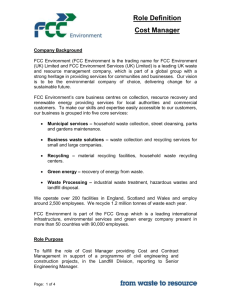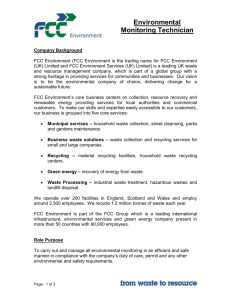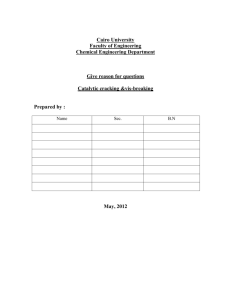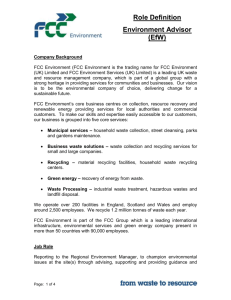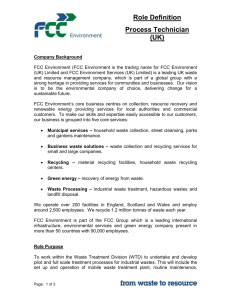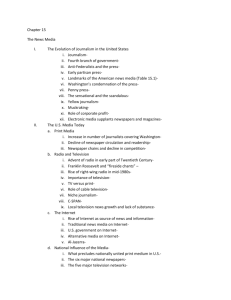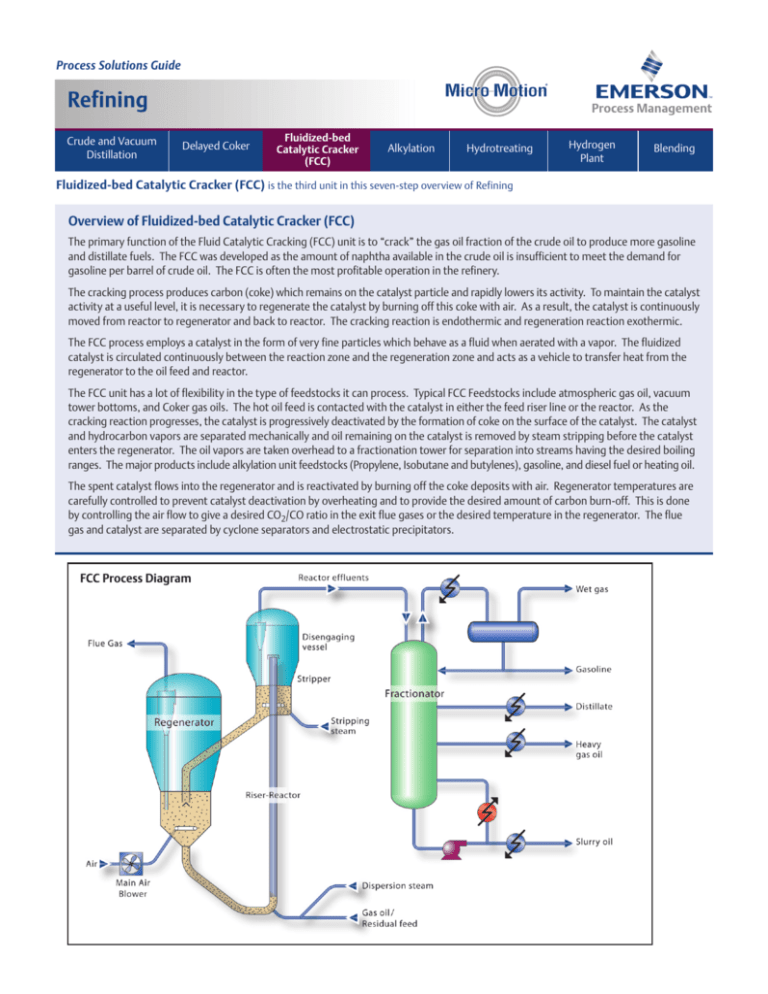
Process Solutions Guide
Refining
Crude and Vacuum
Distillation
Delayed Coker
Fluidized-bed
Catalytic Cracker
(FCC)
Alkylation
Hydrotreating
Hydrogen
Plant
Blending
Fluidized-bed Catalytic Cracker (FCC) is the third unit in this seven-step overview of Refining
Overview of Fluidized-bed Catalytic Cracker (FCC)
The primary function of the Fluid Catalytic Cracking (FCC) unit is to “crack” the gas oil fraction of the crude oil to produce more gasoline
and distillate fuels. The FCC was developed as the amount of naphtha available in the crude oil is insufficient to meet the demand for
gasoline per barrel of crude oil. The FCC is often the most profitable operation in the refinery.
The cracking process produces carbon (coke) which remains on the catalyst particle and rapidly lowers its activity. To maintain the catalyst
activity at a useful level, it is necessary to regenerate the catalyst by burning off this coke with air. As a result, the catalyst is continuously
moved from reactor to regenerator and back to reactor. The cracking reaction is endothermic and regeneration reaction exothermic.
The FCC process employs a catalyst in the form of very fine particles which behave as a fluid when aerated with a vapor. The fluidized
catalyst is circulated continuously between the reaction zone and the regeneration zone and acts as a vehicle to transfer heat from the
regenerator to the oil feed and reactor.
The FCC unit has a lot of flexibility in the type of feedstocks it can process. Typical FCC Feedstocks include atmospheric gas oil, vacuum
tower bottoms, and Coker gas oils. The hot oil feed is contacted with the catalyst in either the feed riser line or the reactor. As the
cracking reaction progresses, the catalyst is progressively deactivated by the formation of coke on the surface of the catalyst. The catalyst
and hydrocarbon vapors are separated mechanically and oil remaining on the catalyst is removed by steam stripping before the catalyst
enters the regenerator. The oil vapors are taken overhead to a fractionation tower for separation into streams having the desired boiling
ranges. The major products include alkylation unit feedstocks (Propylene, Isobutane and butylenes), gasoline, and diesel fuel or heating oil.
The spent catalyst flows into the regenerator and is reactivated by burning off the coke deposits with air. Regenerator temperatures are
carefully controlled to prevent catalyst deactivation by overheating and to provide the desired amount of carbon burn-off. This is done
by controlling the air flow to give a desired CO2/CO ratio in the exit flue gases or the desired temperature in the regenerator. The flue
gas and catalyst are separated by cyclone separators and electrostatic precipitators.
FCC Process Diagram
Refining – Fluid Catalytic Cracking (FCC)
Process Solutions Guide
Customer Challenges
The FCC unit is often the most profitable operation in the refinery, with net profits commonly in the range of
$250,000 to $500,000 a day for a unit with a capacity of 50,000 BPD. As a result, the reliability, or availability of this
unit is the most important concern for the refiner. Anything that will contribute to keeping the unit up and running
optimally is of interest.
The following customer challenges have been defined and Micro Motion offers integrated application solutions that
provide everything needed to meet these challenges and improve quality, productivity, and profitability.
Customer Process Challenge #1 – Maximizing Feed Rate
Challenge: The feed rate to the FCC should be maximized within the existing unit constraints including air blower and
gas compressor capacity, catalyst circulation, and alkylation capacity. Accurately measuring each of the feed stream flow
rates is important to maximize the total feed. Also knowing the density of each of the components and the total feed
is important for feed forward control.
Customer Process Challenge #2 – Unit Mass Balance
Challenge: Getting an accurate and reliable mass balance around the FCC unit is challenging because of the constant
changes in the composition of feed and product streams. An accurate mass balance is critical for unit evaluation and
optimization. Accurate measurement of the slurry oil is particularly difficult because of its abrasive nature. Minimizing
slurry oil make is important, so measuring it accurately is important.
Refining – Fluid Catalytic Cracking (FCC)
Improving Efficiency
Customer Challenge #1 - Maximizing Feed Rate
Process Solutions Guide
Recommended Product Solution
Micro Motion ELITE CMF400, ELITE CMF400A or D600
Control Point Challenge: Maximizing feed rate
Application
Solution: Accurate feed rate control to the FCC is important
in terms of maximizing flow to the unit, but also for
production accounting purposes and following the refinery
LP to maximize profitability. Measurement of feed density
is also helpful to unit operations.
FCC feed flows, sometimes
multiple streams from
different sources.
Several key features of the new Micro Motion meters which
can benefit flow measurement in this application include:
• flow calibration verification
• no need to zero
The flow verification and zero-free features are both of
interest because of the fact that this unit operates
continuously for 3-5 years before shutting down for
maintenance. Verifying the flow measurement during
this period is very beneficial.
Competing Technology: Orifice dP
Customer Challenge #2 - Unit Mass Balance
Control Point Challenge: FCC material balance
Solution: Direct mass measurement, which is independent
of composition changes leads to very accurate and reliable
measurement for all fluid streams around the FCC, allowing
for an accurate material balance.
Competing Technology: Orifice dP
MC-00939
©2008. Emerson Process Management, Inc. All rights reserved.
Micro Motion ELITE CMF200, ELITE CMF300, ELITE CMF300A,
ELITE CMF400, ELITE CMF400A
Application
FCC feed, fractionator
products including slurry
oil



